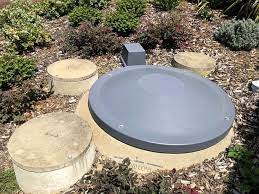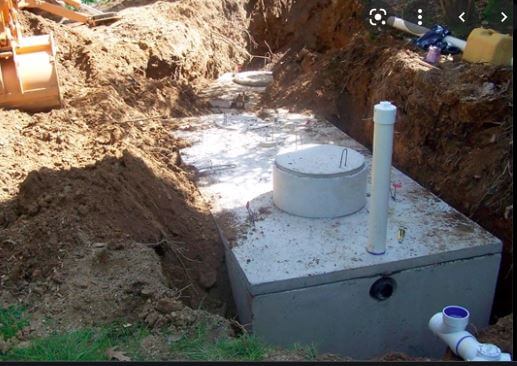When seeking financing options for your home, you want to get the best bang for your buck.
This means comparing the different lenders to get the best rates but it also means having a detailed and accurate estimate of what the new house will cost.
But unbeknownst to most, some additional costs might cause the price to shoot higher than the quote given by the realtor.
For instance, if you need to install a new septic tank on the property, then you may want to consider how much it will cost.
So, how much does a concrete septic tank cost to install?
Well, there is no one-size-fits-all answer because the overall cost will be influenced by the different characteristics of the septic tank.
For instance, it makes sense that a bigger tank will cost more than a smaller one.
Let’s look at this and many other determinants of price in greater detail below:
Size, Weight, Strength
Concrete septic tanks are typically precast although it is still possible to make them on-site.
The least amount you can expect to spend on a concrete septic tank is $500, which is the national minimum cost.
However, most people spend around $1,500 although it is possible to spend as much as $5,000.
The size you pick will be determined by how many bedrooms you have.
The following is a simple table guide for the different septic tank sizes and their costs.
| Septic Tank Size | Average Installation Cost |
| 750 gallon | $1,900 |
| 1,000 gallon | $1,250 |
| 1,250 gallon | $1,500 |
| 1,500 gallon | $1,875 |
| 1,600 gallon | $1,950 |
| 2,000 gallon | $2,500 |
| 3000 gallon | $3,500 |
These estimates are based on the assumption that you will install a single-compartment septic tank.
However, it is not uncommon to have double or even triple-compartment septic tanks which are considered more efficient and durable.
As you may guess, a double-compartment septic tank will cost much more than a single-compartment septic tank, so the estimates given above could easily double or even triple.
Design and Installation

The design and installation of the septic tank also play a role in determining the cost.
If you choose a more complex design, it will increase the cost of installation.
In addition, the cost of installation will also depend on the experience and skill of the installer.
A professional and experienced installer will charge more for their services, but they will ensure a proper installation.
If you are not a septic system professional, then you will have to part with some cash to hire a professional to do it for you.
The labor costs for installing a septic system will also vary by contractor but Forbes estimates that you will part with anything from $1,500 – $4,000 and this cost should cover both the design and installation of the septic system.
Obviously, these costs do not include the cost of purchasing the actual concrete tank and other components.
Excavation
Excavation is often overlooked by most homeowners but it’s a necessary step in the installation process.
It can also gobble up a tidy sum depending on the gradient, soil condition, ease of access, time of year, and other factors.
On average, the excavation cost can be in the range of $1,200 – $4,500 although getting an accurate estimate is hard because there are too many variables that will affect the cost.
Permits
Before the septic tank professional can commence the installation, the necessary permits need to be in place.
Each local government has different laws and guidelines for septic tank installation which also means the cost of permits needed will depend on your local government.
But for the most part, permits shouldn’t exceed $1,000.
Related: Do You Need A Permit To Repair A Septic System?
Drain Field
The drain field is another important component of the septic system.
The cost of the drain field will depend on the size and complexity of the installation.
For instance, the larger and more complex a drain field is, the more money it will cost.
Here are some ballpark estimates to give you a rough idea of the costs:
| Drain Field Type | Cost |
| Anaerobic drain field | $2,000 – $6,000 |
| Aerobic drain field | $ 7,000 -$ 10,000 |
| Evapotranspiration drain field | $ 8,000 – $ 15,000 |
| Mound drain field | $10,000 – $20,000 |
Pipes, Risers, Lids

In addition to the tank, you have to also consider the costs of pipes, risers, and lids that will be needed for the project.
Even though there are different types of septic systems, all of them still rely on pipes to convey the sewage from the house into the septic tank.
The cost of pipes will depend on how much distance is covered by these pipes, so you may want to talk to the design engineer to figure out the exact cost.
As a working estimate, you can get 100 feet of PVC pipes for around $80.
The lid is equally cheap because it goes for around $50-$100 depending on material and size.
As for the septic risers, you should spend approximately $200-$400.
Labor Costs
As we have already established, you will need to hire a qualified septic tank professional to help you with the installation.
This is one cost you do not want to skimp on because if the installation is not done right, you could end up with a failed system which is not only a nuisance but it will end up costing you a lot of money to fix.
Plus, you could be fined by the local authority for causing pollution to the groundwater because of a failed septic system.
If the estimates provided by Forbes are anything to go by, prepare to spend anything from $1,500 – $4,000 on labor costs alone.
Maintenance
Once you start using the septic tank, you will have to maintain it to ensure it works efficiently for as long as possible.
In fact, you are required by law to pump your septic tank every 3-5 years depending on your location.
Pumping the septic tank will set you back $300-$500 depending on the size of the tank.
However, this is almost a negligible cost, especially because you only do it periodically.
Besides, it might even be cheaper than being connected to municipal wastewater treatment.
Tips for Saving Costs

The following are a couple of useful hacks that can help you save some money when installing a septic system on your property.
I. Choose A Smaller Tank
As we have already seen, a smaller tank will cost less to purchase, install, and maintain.
If a smaller tank is sufficient for your situation, you may want to choose it.
For instance, if you are installing a tank in your wood cabin that you only visit twice a year, there is really no need to go all out and install a massive tank.
However, check the local regulations to ensure you are within the law on the size you chose.
II. Shop around
Anyone in procurement will tell you that it’s standard procedure to get at least three quotes before settling on a service provider.
Do not just go with the first quote you get but ask around to make sure you are getting value for your money.
III. Pick a suitable site
The site you pick can also determine the cost of the project.
For instance, picking a hard-to-access site will mean spending lots more on excavation.
Additionally, the type of soil on the site will also determine the type of septic tank that you can install which will also affect the price.
IV. Go for a package solution
It is often cheaper to go for a package solution instead of fragmenting the job.
Look for a good septic tank professional who can do everything from designing to installing the system.
The contractor may charge a standard rate and not include additional charges for other smaller things like plumbing which might save you some good money.
Check out the following posts for more information on septic system repair and maintenance costs:
